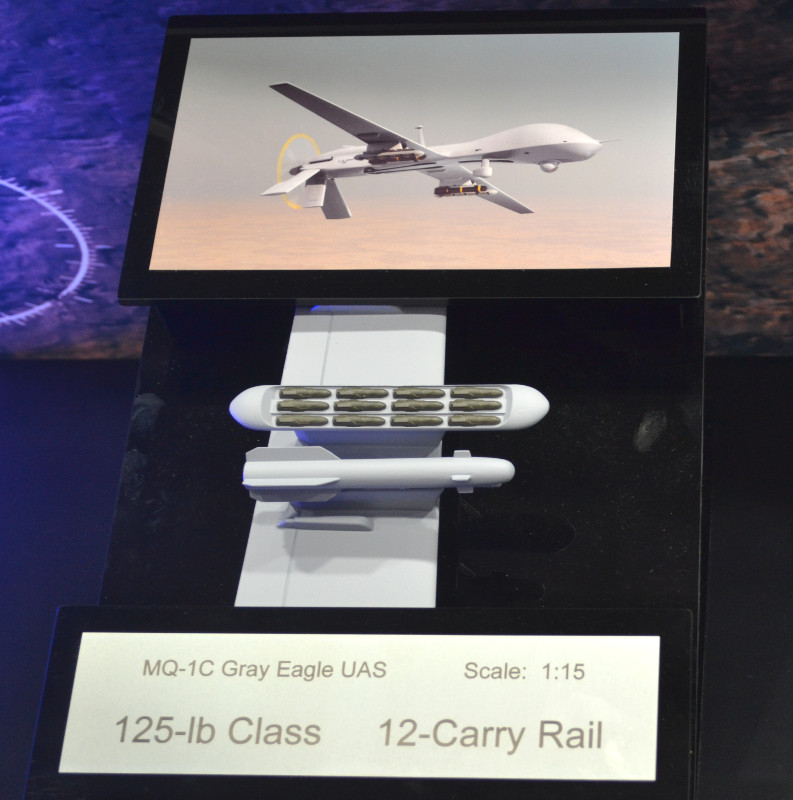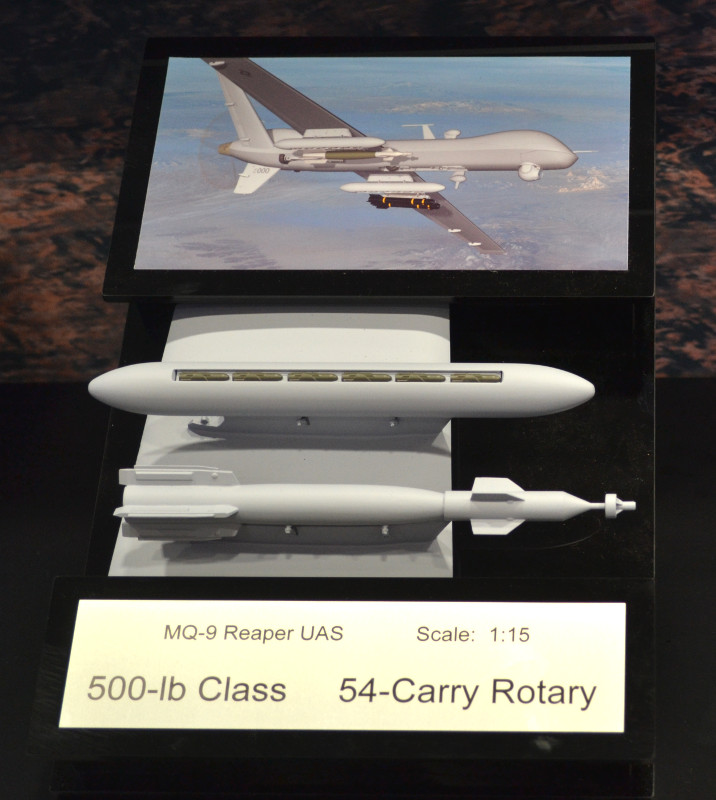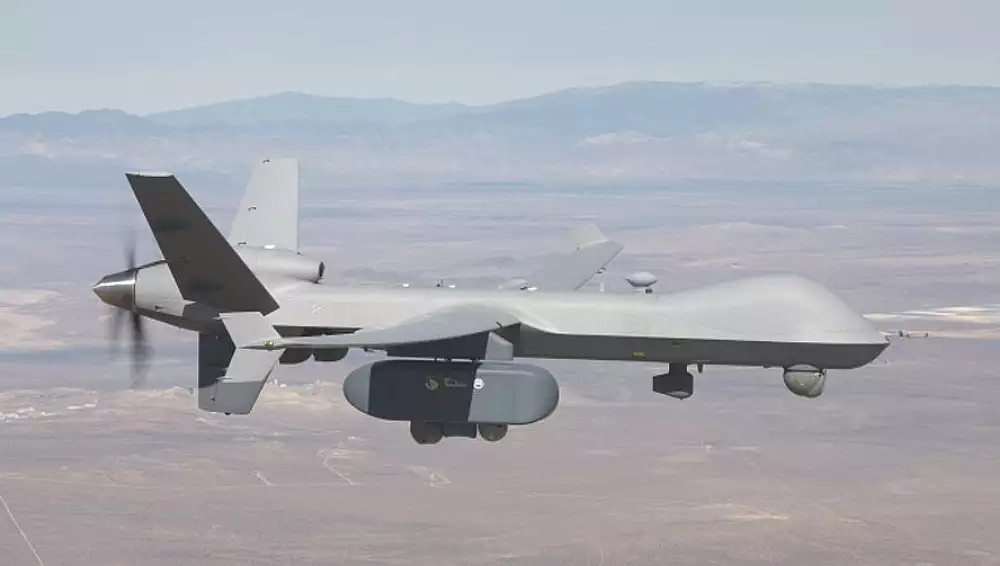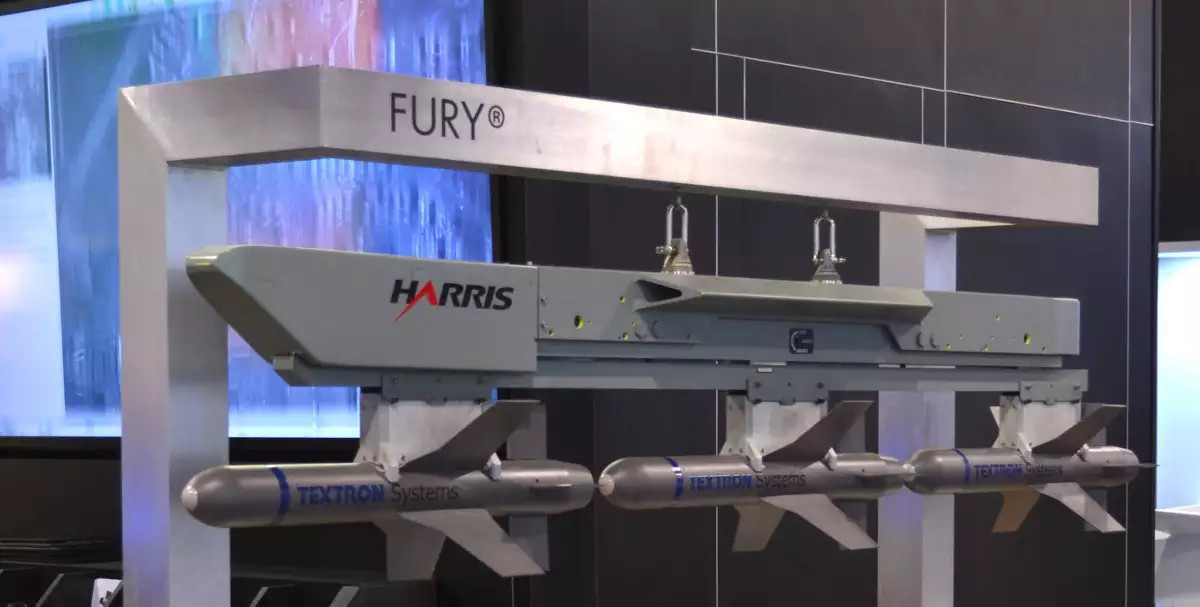The U.S. Army is considering the Hatchet miniature munition, a tiny precision glide bomb, as a possible future armament option for its MQ-1C Gray Eagle drones together with dispenser pods that could let a single one of the unmanned aircraft carry dozens of them at a time. At the same time, the manufacturer, Northrop Grumman, is proposing larger systems that would enable MQ-9 Reapers in service with the U.S. Air Force to carry hundreds of the weapons on a single mission.
Orbital ATK first unveiled Hatchet, which weighs approximately eight pounds and has a three-pound warhead, in 2012. Northrop Grumman finished its acquisition of the Virginia-headquartered defense and space systems firm, in June 2018, subsequently renaming it as their Innovation Systems division.
The Army’s interest in Hatchet stems primarily from a desire to increase the number of total targets a single MQ-1C can engage over the course of one sortie, a Northrop Grumman representative explained to The War Zone at the annual Association of the U.S. Army (AUSA) meeting and exhibition in Washington, D.C. on Oct. 8, 2018. On a mission that might last 36 hours or more, depending on the exact Gray Eagle variant and loadout, crews may decide not to strike targets of opportunity early on for fear of not having ordnance in more critical situations, such as a call to provide close air support for friendly troops ground.
At present, the MQ-1C’s can carry a maximum of four AGM-114 Hellfire laser-guided missiles on four separate underwing pylons. Northrop Grumman is working on a 125-pound class dispenser that would remain attached to the drone and would be able to carry 12 Hatchets at a time on a single pylon.

The tiny glide bombs are still in development, but Northrop Grumman plans to offer them with a variety of guidance options, including a GPS/INS system by itself, as well as that coupled with a laser or imaging infrared seeker. The weapon may even come with a semi-active millimeter wave radar capability in the future.
This mix of options would give Hatchet the ability to strike in poor weather and against moving targets, as well as be able to automatically detect and engage those targets. In the dual-mode configurations, the GPS/INS guidance system steers the weapon to the general target area before the second seeker takes over.
A single 12-weapon dispenser could carry a mix of types that would give a single MQ-1C more flexibility to engage those targets regardless of the environmental and other factors, as well. Clouds, smoke, and other obscurants can impair the ability for laser designators to mark a target, which could limit the ability of a drone carrying only Hellfires to engage the enemy.
One of the most immediate target sets for Hatchet would be targeted strikes against particular terrorists or small groups of militants in the open or traveling in light vehicles. The small size of the warhead would also give Gray Eagle crews a better option when conducting those strikes in dense, urban areas or when the targets might otherwise be close to innocent civilians or their homes.

But improved fragmentation warhead technology, also known as “alternative warheads,” which the U.S. military has been working on as a substitute for cluster munitions, will reportedly give Hatchet, or at least certain variants, enhanced wide-area effects against more conventional, unarmored targets in the open, as well. It will only take six of them to saturate an area the size of a football field with a hail of shrapnel, according to the manufacturer. Whatever the exact target set, a single MQ-1C carrying four dispensers for a total of 48 Hatchets would be able to quickly engage multiple targets across a broad area.
The MQ-9s, which can carry much larger stores, could see an even bigger boost in capability with Hatchet. Northrop Grumman is working on a larger, 500-pound class pod for those drones, each one of which will be able to carry 54 of the miniature munitions. Again, this unit would remain attached to the aircraft and a rotary launcher inside would dispense the glide bombs through a port in the bottom.

A single Reaper could conceivably carry as many as 216 of these weapons at a time, dramatically increasing its magazine depth and giving it the ability to continuing striking at targets throughout long-duration missions. With so many munitions on a single pylon, it could also allow for more flexibility in load outs, allowing both the Reapers and the Gray Eagles to carry underwing sensor and electronic warfare systems, as appropriate, but without necessarily sacrificing the total number of targets they would be able to strike in a single mission.
The Hatchet dispensers could be an attractive option for other aircraft, as well. We at The War Zone have already discussed in detail the benefits the system could offer to stealthy aircraft, such as the F-35 Joint Strike Fighter, which have limited space and significant dimensional constraints inside their internal weapons bays.
But the dispensers should be compatible with any aircraft or helicopter that can carry similar 125-pound or 500-pound class munitions, as well. Northrop Grumman designed the 12-bomb system to fit any pylon that can accept a Hellfire launch rail for example. This could make it a particularly good option for fixed-wing light attack aircraft loitering over a particular part of the battlefield for extended periods of time.

The 500-pound class system could exponentially increase the number of individual targets a larger tactical aircraft, such as an F-15E Strike Eagle, or even a bomber would be able to engage, too. A B-52 bomber just carrying nine of these pods under its wings would have nearly 490 Hatchets to dispense, with the potential of creating seamless effects over an area equivalent to more than 80 football fields. The munition’s precision guidance means this wouldn’t need to be a linear carpet bombing run, either, with the plane’s crew able to saturate enemy positions at specific points along a general flight path, while still avoiding areas where collateral damage and civilian casualties are an issue.
If the pod works with an internal, rotary launcher, like those found on B-52s, as well as B-1s or B-2s, those bombers might be able to launch thousands of Hatchets in a single sortie, with each hitting a precision target or working to clear a certain defined geographical area. This would enable them to decimate hundreds of individual exposed targets at a particular site and on a single pass, such as a sprawling air base, and still have the capacity to carry a smaller number of larger weapons to destroy hardened structures.
In other words, a single bomber could decimate a target set that would have many aircraft in the past, all with extreme precision and the ability to leave critical infrastructure intact. Currently, the closest operation capability to this is the B-2’s ability to carry 80 500lb JDAMs, and those are still huge bombs with large blast radii compared to a weapon like Hatchet.
A larger 1,000- or 2,000-pound class dispenser would only further increase the number of Hatchets these aircraft could carry, too.
It’s not clear when the Army might make a final decision on what miniature munitions it will add to the arsenal of its MQ-1Cs. Other competitors might include Textron’s Fury and Raytheon’s Pyros, both of which are also multi-mode glide bombs. These firms have proposed more conventional multiple ejector racks for their weapons rather than high-capacity dispensers.

The service is formally working in that direction, though, and has funding for the project in the 2019 Fiscal Year budget. The Air Force and Special Operations Command are not as far along in deciding how to expand the MQ-9’s armament, according to Northrop Grumman’s representative at the AUSA expo.
Depending on what route the Army takes, we may not have to wait long before we start seeing Gray Eagle drones armed with dozens of miniature precision-guided bombs.
Contact the author: jtrevithickpr@gmail.com
